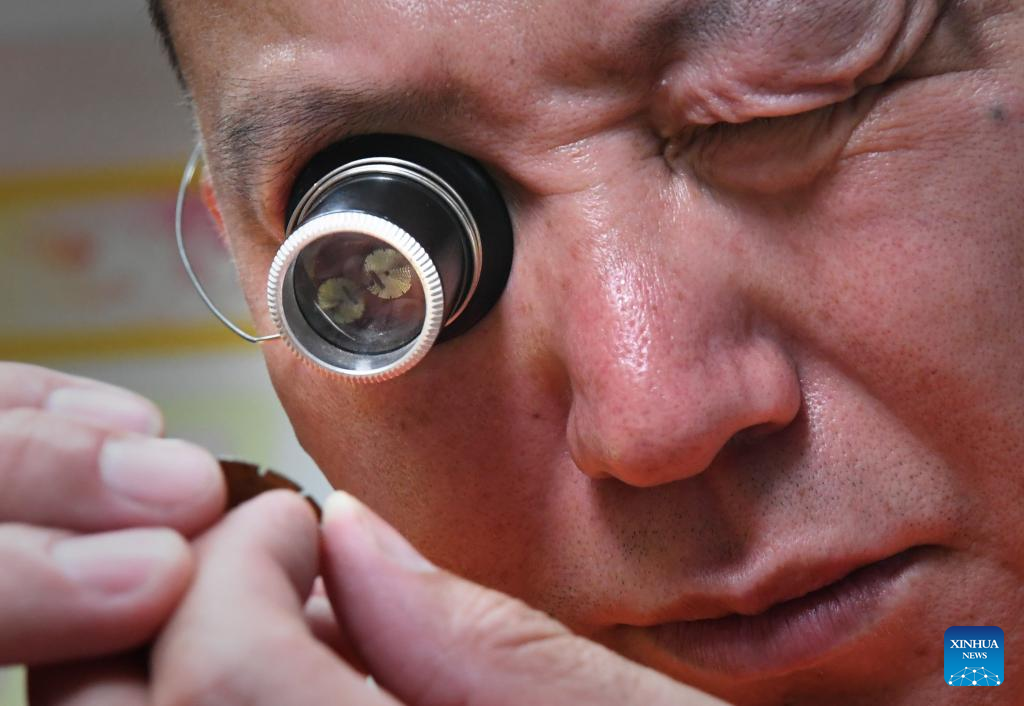
Cheng Yucai checks a processed dial at his workshop in Xinmi City, central China's Henan Province, on May 24, 2022.
Guilloche is a decorative technique in which a precise, intricate and repetitive pattern is mechanically engraved into a material via engine turning. The technique uses a machine controlled by the delicacy of the hand of craftsman. As an important process in making superior watch and jewelry, the art is now mastered by rarely few people.
Cheng Yucai, born in 1978, got to know Guilloche in 2013 when he saw a cigarette case decorated with the technique. He was attracted by the delicacy and decided to devote himself into the art. In 2015, he resigned from his work in a silverwork factory and began his career in Guilloche. After countless failures and costs of materials, Cheng finally created an integrated Guilloche machine, which was granted with the country's patent of invention in 2017. His skills also amazed professional judges during the first national vocational skills competition in 2020.
Nowadays, Cheng's craft has been widely recognized by foreign customers, especially in France and Switzerland, who often book custom-made Guilloche designs from him. Cheng Yucai's workshop, which he names "Sanloutang" and is located in a kiln of Xinmi City of central China's Henan, is simple and crude but quiet enough for him to focus on the art. He moved to the vocational education center of Xinmi after the kiln was flooded by rainfall last summer, waiting for the fix of the workshop.
Guilloche requires delicacy of the craftsman, which includes a dozen processes such as flattening, underlining and carving. The precision is accurate to twentieth of the width of a hair. A simple Guilloche pattern costs seven to eight hours to make with 70,000 to 80,000 times turning of manual operation, while a complex one dozens of hours with more than 100,000 times turning. Any tiny mistake would make the whole work useless.
Nowadays, Cheng has enrolled three apprentices, to whom he teaches all the skills without reservation. Generally grasping the art, his apprentices are ready to take part in a world technique competition in October. "I wish the art would be passed through generations and be known and loved by more people, " Cheng said. (Xinhua/Li An)
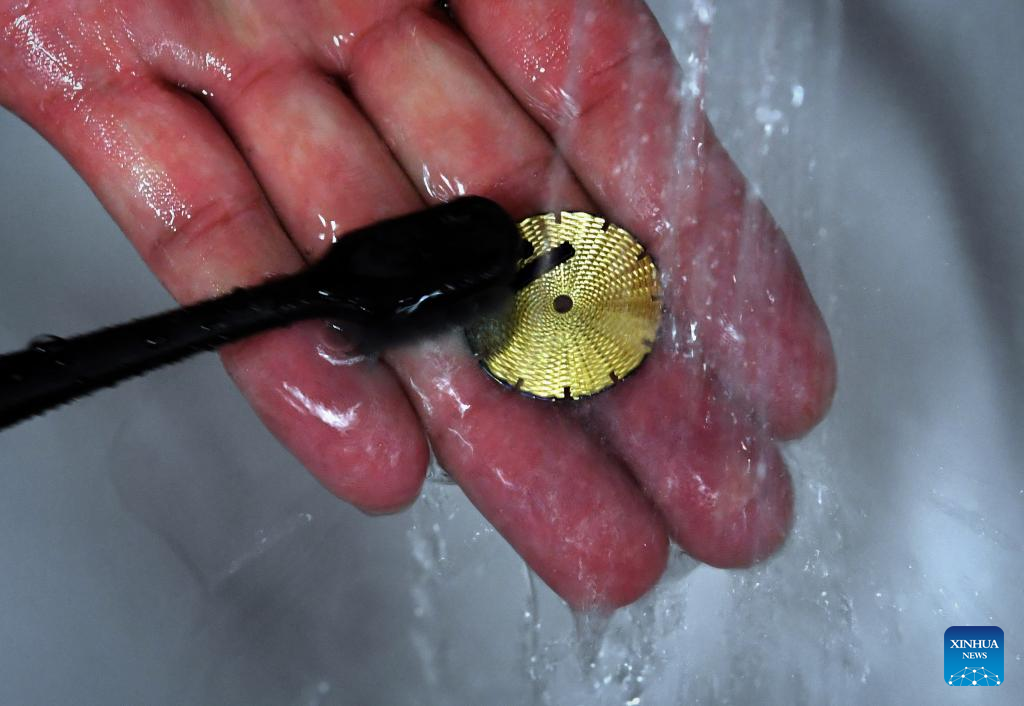
Cheng Yucai washes a dial after heating it at his workshop in Xinmi City, central China's Henan Province, on May 24, 2022.
Guilloche is a decorative technique in which a precise, intricate and repetitive pattern is mechanically engraved into a material via engine turning. The technique uses a machine controlled by the delicacy of the hand of craftsman. As an important process in making superior watch and jewelry, the art is now mastered by rarely few people.
Cheng Yucai, born in 1978, got to know Guilloche in 2013 when he saw a cigarette case decorated with the technique. He was attracted by the delicacy and decided to devote himself into the art. In 2015, he resigned from his work in a silverwork factory and began his career in Guilloche. After countless failures and costs of materials, Cheng finally created an integrated Guilloche machine, which was granted with the country's patent of invention in 2017. His skills also amazed professional judges during the first national vocational skills competition in 2020.
Nowadays, Cheng's craft has been widely recognized by foreign customers, especially in France and Switzerland, who often book custom-made Guilloche designs from him. Cheng Yucai's workshop, which he names "Sanloutang" and is located in a kiln of Xinmi City of central China's Henan, is simple and crude but quiet enough for him to focus on the art. He moved to the vocational education center of Xinmi after the kiln was flooded by rainfall last summer, waiting for the fix of the workshop.
Guilloche requires delicacy of the craftsman, which includes a dozen processes such as flattening, underlining and carving. The precision is accurate to twentieth of the width of a hair. A simple Guilloche pattern costs seven to eight hours to make with 70,000 to 80,000 times turning of manual operation, while a complex one dozens of hours with more than 100,000 times turning. Any tiny mistake would make the whole work useless.
Nowadays, Cheng has enrolled three apprentices, to whom he teaches all the skills without reservation. Generally grasping the art, his apprentices are ready to take part in a world technique competition in October. "I wish the art would be passed through generations and be known and loved by more people, " Cheng said. (Xinhua/Li Jianan)
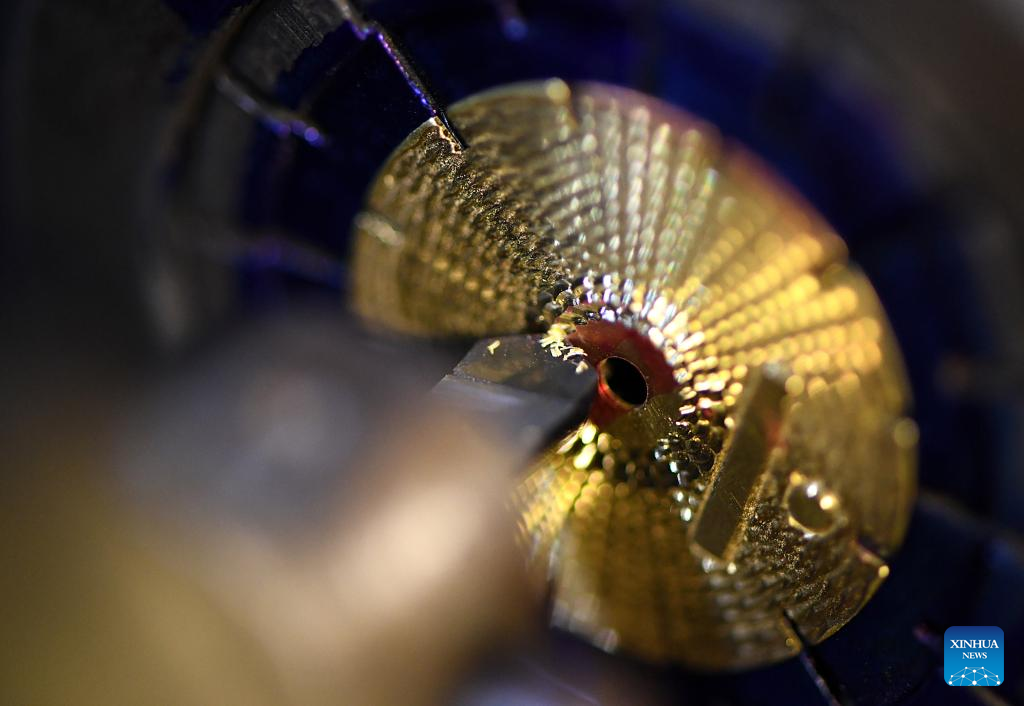
Cheng Yucai engraves on a dial by a Guilloche machine at his workshop in Xinmi City, central China's Henan Province, on May 23, 2022.
Guilloche is a decorative technique in which a precise, intricate and repetitive pattern is mechanically engraved into a material via engine turning. The technique uses a machine controlled by the delicacy of the hand of craftsman. As an important process in making superior watch and jewelry, the art is now mastered by rarely few people.
Cheng Yucai, born in 1978, got to know Guilloche in 2013 when he saw a cigarette case decorated with the technique. He was attracted by the delicacy and decided to devote himself into the art. In 2015, he resigned from his work in a silverwork factory and began his career in Guilloche. After countless failures and costs of materials, Cheng finally created an integrated Guilloche machine, which was granted with the country's patent of invention in 2017. His skills also amazed professional judges during the first national vocational skills competition in 2020.
Nowadays, Cheng's craft has been widely recognized by foreign customers, especially in France and Switzerland, who often book custom-made Guilloche designs from him. Cheng Yucai's workshop, which he names "Sanloutang" and is located in a kiln of Xinmi City of central China's Henan, is simple and crude but quiet enough for him to focus on the art. He moved to the vocational education center of Xinmi after the kiln was flooded by rainfall last summer, waiting for the fix of the workshop.
Guilloche requires delicacy of the craftsman, which includes a dozen processes such as flattening, underlining and carving. The precision is accurate to twentieth of the width of a hair. A simple Guilloche pattern costs seven to eight hours to make with 70,000 to 80,000 times turning of manual operation, while a complex one dozens of hours with more than 100,000 times turning. Any tiny mistake would make the whole work useless.
Nowadays, Cheng has enrolled three apprentices, to whom he teaches all the skills without reservation. Generally grasping the art, his apprentices are ready to take part in a world technique competition in October. "I wish the art would be passed through generations and be known and loved by more people, " Cheng said. (Xinhua/Li An)
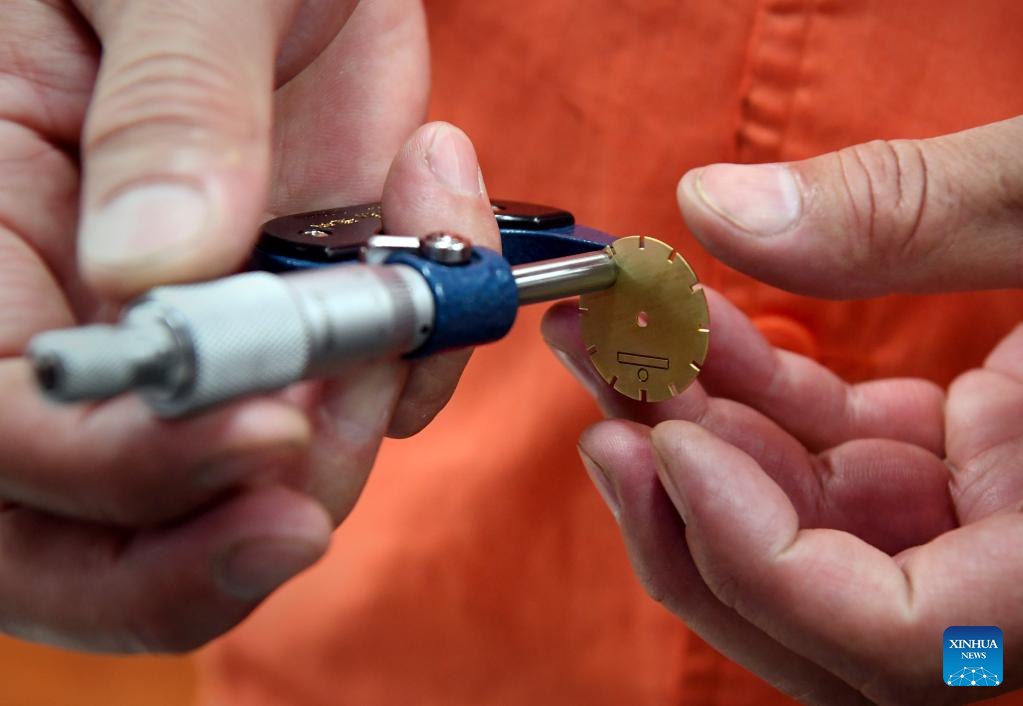
Cheng Yucai measures a processed dial at his workshop in Xinmi City, central China's Henan Province, on May 23, 2022.
Guilloche is a decorative technique in which a precise, intricate and repetitive pattern is mechanically engraved into a material via engine turning. The technique uses a machine controlled by the delicacy of the hand of craftsman. As an important process in making superior watch and jewelry, the art is now mastered by rarely few people.
Cheng Yucai, born in 1978, got to know Guilloche in 2013 when he saw a cigarette case decorated with the technique. He was attracted by the delicacy and decided to devote himself into the art. In 2015, he resigned from his work in a silverwork factory and began his career in Guilloche. After countless failures and costs of materials, Cheng finally created an integrated Guilloche machine, which was granted with the country's patent of invention in 2017. His skills also amazed professional judges during the first national vocational skills competition in 2020.
Nowadays, Cheng's craft has been widely recognized by foreign customers, especially in France and Switzerland, who often book custom-made Guilloche designs from him. Cheng Yucai's workshop, which he names "Sanloutang" and is located in a kiln of Xinmi City of central China's Henan, is simple and crude but quiet enough for him to focus on the art. He moved to the vocational education center of Xinmi after the kiln was flooded by rainfall last summer, waiting for the fix of the workshop.
Guilloche requires delicacy of the craftsman, which includes a dozen processes such as flattening, underlining and carving. The precision is accurate to twentieth of the width of a hair. A simple Guilloche pattern costs seven to eight hours to make with 70,000 to 80,000 times turning of manual operation, while a complex one dozens of hours with more than 100,000 times turning. Any tiny mistake would make the whole work useless.
Nowadays, Cheng has enrolled three apprentices, to whom he teaches all the skills without reservation. Generally grasping the art, his apprentices are ready to take part in a world technique competition in October. "I wish the art would be passed through generations and be known and loved by more people, " Cheng said. (Xinhua/Li Jianan)
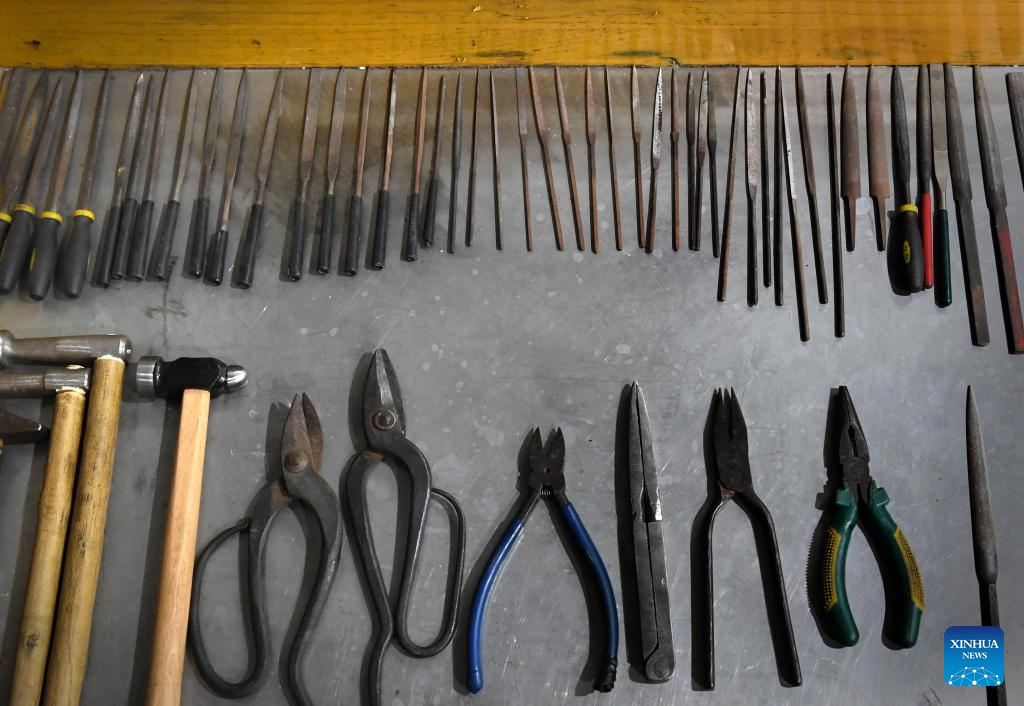
Photo taken on May 24, 2022 shows tools of Cheng Yucai at his workshop in Xinmi City, central China's Henan Province.
Guilloche is a decorative technique in which a precise, intricate and repetitive pattern is mechanically engraved into a material via engine turning. The technique uses a machine controlled by the delicacy of the hand of craftsman. As an important process in making superior watch and jewelry, the art is now mastered by rarely few people.
Cheng Yucai, born in 1978, got to know Guilloche in 2013 when he saw a cigarette case decorated with the technique. He was attracted by the delicacy and decided to devote himself into the art. In 2015, he resigned from his work in a silverwork factory and began his career in Guilloche. After countless failures and costs of materials, Cheng finally created an integrated Guilloche machine, which was granted with the country's patent of invention in 2017. His skills also amazed professional judges during the first national vocational skills competition in 2020.
Nowadays, Cheng's craft has been widely recognized by foreign customers, especially in France and Switzerland, who often book custom-made Guilloche designs from him. Cheng Yucai's workshop, which he names "Sanloutang" and is located in a kiln of Xinmi City of central China's Henan, is simple and crude but quiet enough for him to focus on the art. He moved to the vocational education center of Xinmi after the kiln was flooded by rainfall last summer, waiting for the fix of the workshop.
Guilloche requires delicacy of the craftsman, which includes a dozen processes such as flattening, underlining and carving. The precision is accurate to twentieth of the width of a hair. A simple Guilloche pattern costs seven to eight hours to make with 70,000 to 80,000 times turning of manual operation, while a complex one dozens of hours with more than 100,000 times turning. Any tiny mistake would make the whole work useless.
Nowadays, Cheng has enrolled three apprentices, to whom he teaches all the skills without reservation. Generally grasping the art, his apprentices are ready to take part in a world technique competition in October. "I wish the art would be passed through generations and be known and loved by more people, " Cheng said. (Xinhua/Li Jianan)
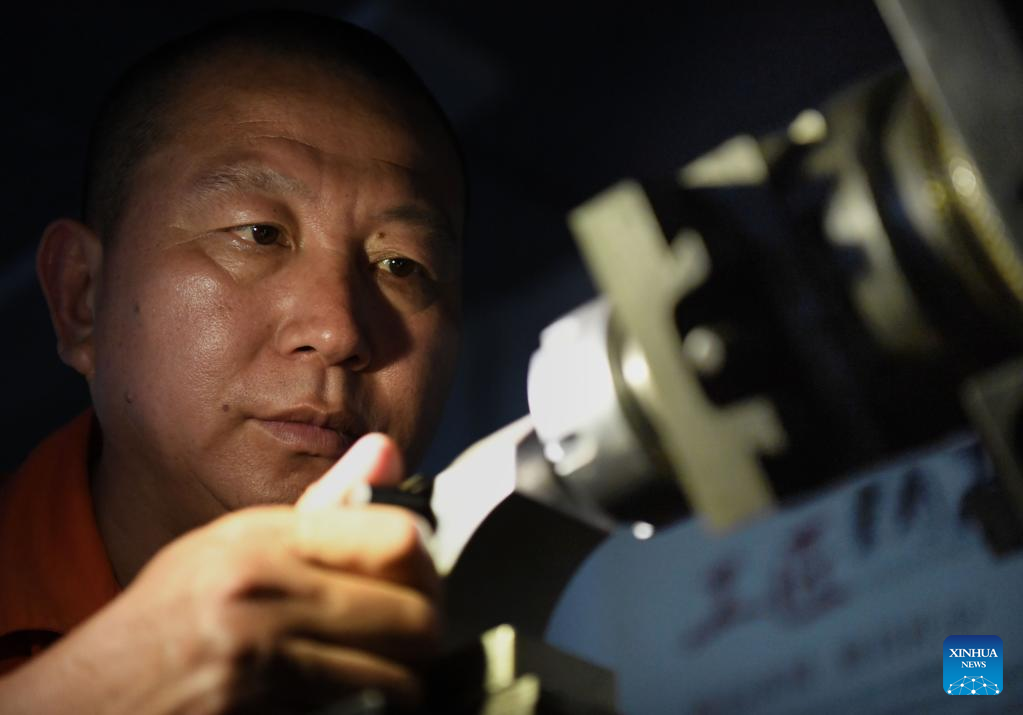
Cheng Yucai operates a Guilloche machine at his workshop in Xinmi City, central China's Henan Province, on May 24, 2022.
Guilloche is a decorative technique in which a precise, intricate and repetitive pattern is mechanically engraved into a material via engine turning. The technique uses a machine controlled by the delicacy of the hand of craftsman. As an important process in making superior watch and jewelry, the art is now mastered by rarely few people.
Cheng Yucai, born in 1978, got to know Guilloche in 2013 when he saw a cigarette case decorated with the technique. He was attracted by the delicacy and decided to devote himself into the art. In 2015, he resigned from his work in a silverwork factory and began his career in Guilloche. After countless failures and costs of materials, Cheng finally created an integrated Guilloche machine, which was granted with the country's patent of invention in 2017. His skills also amazed professional judges during the first national vocational skills competition in 2020.
Nowadays, Cheng's craft has been widely recognized by foreign customers, especially in France and Switzerland, who often book custom-made Guilloche designs from him. Cheng Yucai's workshop, which he names "Sanloutang" and is located in a kiln of Xinmi City of central China's Henan, is simple and crude but quiet enough for him to focus on the art. He moved to the vocational education center of Xinmi after the kiln was flooded by rainfall last summer, waiting for the fix of the workshop.
Guilloche requires delicacy of the craftsman, which includes a dozen processes such as flattening, underlining and carving. The precision is accurate to twentieth of the width of a hair. A simple Guilloche pattern costs seven to eight hours to make with 70,000 to 80,000 times turning of manual operation, while a complex one dozens of hours with more than 100,000 times turning. Any tiny mistake would make the whole work useless.
Nowadays, Cheng has enrolled three apprentices, to whom he teaches all the skills without reservation. Generally grasping the art, his apprentices are ready to take part in a world technique competition in October. "I wish the art would be passed through generations and be known and loved by more people, " Cheng said. (Xinhua/Li An)
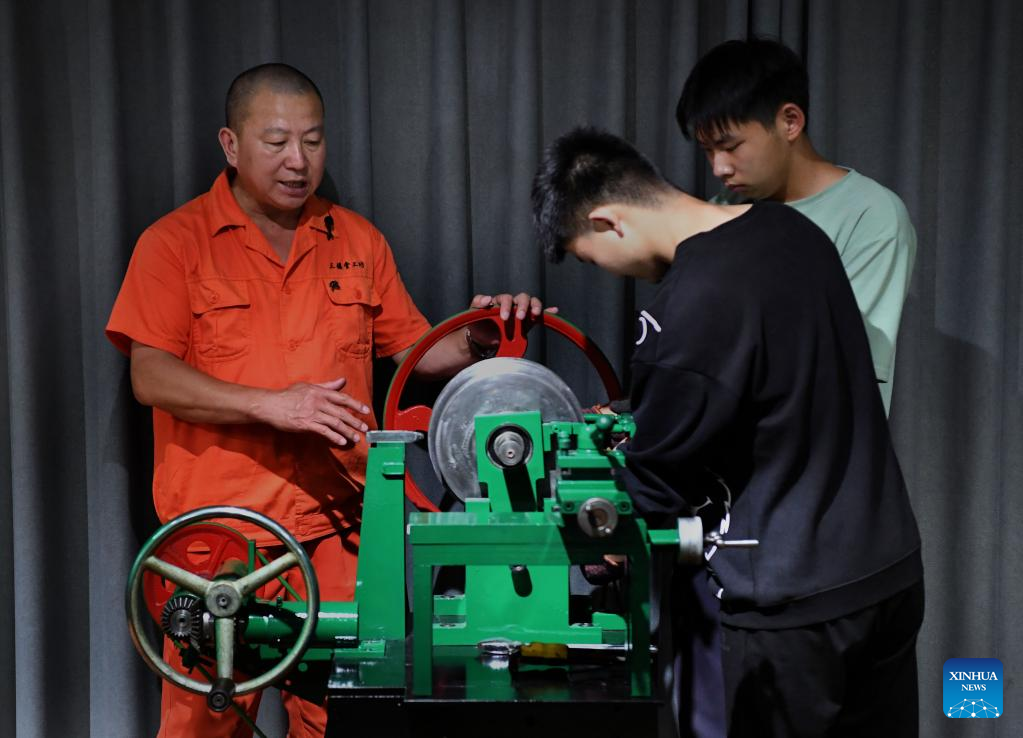
Cheng Yucai (L) guides his apprentices in adjusting a Guilloche machine at his workshop in Xinmi City, central China's Henan Province, on May 24, 2022.
Guilloche is a decorative technique in which a precise, intricate and repetitive pattern is mechanically engraved into a material via engine turning. The technique uses a machine controlled by the delicacy of the hand of craftsman. As an important process in making superior watch and jewelry, the art is now mastered by rarely few people.
Cheng Yucai, born in 1978, got to know Guilloche in 2013 when he saw a cigarette case decorated with the technique. He was attracted by the delicacy and decided to devote himself into the art. In 2015, he resigned from his work in a silverwork factory and began his career in Guilloche. After countless failures and costs of materials, Cheng finally created an integrated Guilloche machine, which was granted with the country's patent of invention in 2017. His skills also amazed professional judges during the first national vocational skills competition in 2020.
Nowadays, Cheng's craft has been widely recognized by foreign customers, especially in France and Switzerland, who often book custom-made Guilloche designs from him. Cheng Yucai's workshop, which he names "Sanloutang" and is located in a kiln of Xinmi City of central China's Henan, is simple and crude but quiet enough for him to focus on the art. He moved to the vocational education center of Xinmi after the kiln was flooded by rainfall last summer, waiting for the fix of the workshop.
Guilloche requires delicacy of the craftsman, which includes a dozen processes such as flattening, underlining and carving. The precision is accurate to twentieth of the width of a hair. A simple Guilloche pattern costs seven to eight hours to make with 70,000 to 80,000 times turning of manual operation, while a complex one dozens of hours with more than 100,000 times turning. Any tiny mistake would make the whole work useless.
Nowadays, Cheng has enrolled three apprentices, to whom he teaches all the skills without reservation. Generally grasping the art, his apprentices are ready to take part in a world technique competition in October. "I wish the art would be passed through generations and be known and loved by more people, " Cheng said. (Xinhua/Li Jianan)

Cheng Yucai selects dyestuff at his workshop in Xinmi City, central China's Henan Province, on May 24, 2022.
Guilloche is a decorative technique in which a precise, intricate and repetitive pattern is mechanically engraved into a material via engine turning. The technique uses a machine controlled by the delicacy of the hand of craftsman. As an important process in making superior watch and jewelry, the art is now mastered by rarely few people.
Cheng Yucai, born in 1978, got to know Guilloche in 2013 when he saw a cigarette case decorated with the technique. He was attracted by the delicacy and decided to devote himself into the art. In 2015, he resigned from his work in a silverwork factory and began his career in Guilloche. After countless failures and costs of materials, Cheng finally created an integrated Guilloche machine, which was granted with the country's patent of invention in 2017. His skills also amazed professional judges during the first national vocational skills competition in 2020.
Nowadays, Cheng's craft has been widely recognized by foreign customers, especially in France and Switzerland, who often book custom-made Guilloche designs from him. Cheng Yucai's workshop, which he names "Sanloutang" and is located in a kiln of Xinmi City of central China's Henan, is simple and crude but quiet enough for him to focus on the art. He moved to the vocational education center of Xinmi after the kiln was flooded by rainfall last summer, waiting for the fix of the workshop.
Guilloche requires delicacy of the craftsman, which includes a dozen processes such as flattening, underlining and carving. The precision is accurate to twentieth of the width of a hair. A simple Guilloche pattern costs seven to eight hours to make with 70,000 to 80,000 times turning of manual operation, while a complex one dozens of hours with more than 100,000 times turning. Any tiny mistake would make the whole work useless.
Nowadays, Cheng has enrolled three apprentices, to whom he teaches all the skills without reservation. Generally grasping the art, his apprentices are ready to take part in a world technique competition in October. "I wish the art would be passed through generations and be known and loved by more people, " Cheng said. (Xinhua/Li Jianan)

Cheng Yucai grinds tools at his workshop in Xinmi City, central China's Henan Province, on May 24, 2022.
Guilloche is a decorative technique in which a precise, intricate and repetitive pattern is mechanically engraved into a material via engine turning. The technique uses a machine controlled by the delicacy of the hand of craftsman. As an important process in making superior watch and jewelry, the art is now mastered by rarely few people.
Cheng Yucai, born in 1978, got to know Guilloche in 2013 when he saw a cigarette case decorated with the technique. He was attracted by the delicacy and decided to devote himself into the art. In 2015, he resigned from his work in a silverwork factory and began his career in Guilloche. After countless failures and costs of materials, Cheng finally created an integrated Guilloche machine, which was granted with the country's patent of invention in 2017. His skills also amazed professional judges during the first national vocational skills competition in 2020.
Nowadays, Cheng's craft has been widely recognized by foreign customers, especially in France and Switzerland, who often book custom-made Guilloche designs from him. Cheng Yucai's workshop, which he names "Sanloutang" and is located in a kiln of Xinmi City of central China's Henan, is simple and crude but quiet enough for him to focus on the art. He moved to the vocational education center of Xinmi after the kiln was flooded by rainfall last summer, waiting for the fix of the workshop.
Guilloche requires delicacy of the craftsman, which includes a dozen processes such as flattening, underlining and carving. The precision is accurate to twentieth of the width of a hair. A simple Guilloche pattern costs seven to eight hours to make with 70,000 to 80,000 times turning of manual operation, while a complex one dozens of hours with more than 100,000 times turning. Any tiny mistake would make the whole work useless.
Nowadays, Cheng has enrolled three apprentices, to whom he teaches all the skills without reservation. Generally grasping the art, his apprentices are ready to take part in a world technique competition in October. "I wish the art would be passed through generations and be known and loved by more people, " Cheng said. (Xinhua/Li An)
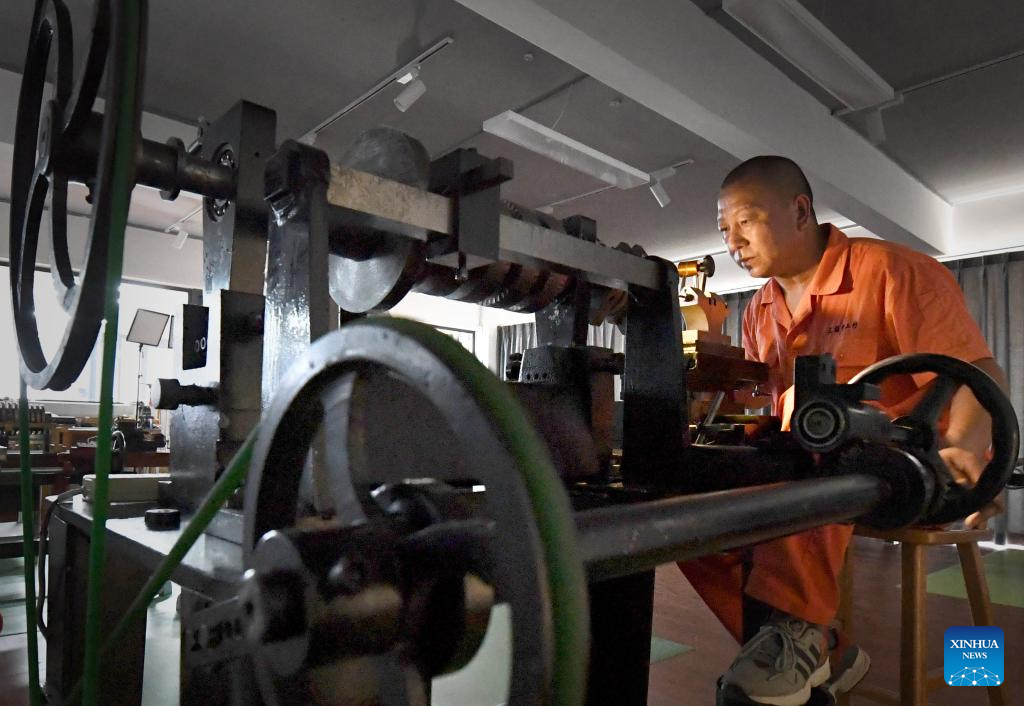
Cheng Yucai works on a dial by a Guilloche machine at his workshop in Xinmi City, central China's Henan Province, on May 23, 2022.
Guilloche is a decorative technique in which a precise, intricate and repetitive pattern is mechanically engraved into a material via engine turning. The technique uses a machine controlled by the delicacy of the hand of craftsman. As an important process in making superior watch and jewelry, the art is now mastered by rarely few people.
Cheng Yucai, born in 1978, got to know Guilloche in 2013 when he saw a cigarette case decorated with the technique. He was attracted by the delicacy and decided to devote himself into the art. In 2015, he resigned from his work in a silverwork factory and began his career in Guilloche. After countless failures and costs of materials, Cheng finally created an integrated Guilloche machine, which was granted with the country's patent of invention in 2017. His skills also amazed professional judges during the first national vocational skills competition in 2020.
Nowadays, Cheng's craft has been widely recognized by foreign customers, especially in France and Switzerland, who often book custom-made Guilloche designs from him. Cheng Yucai's workshop, which he names "Sanloutang" and is located in a kiln of Xinmi City of central China's Henan, is simple and crude but quiet enough for him to focus on the art. He moved to the vocational education center of Xinmi after the kiln was flooded by rainfall last summer, waiting for the fix of the workshop.
Guilloche requires delicacy of the craftsman, which includes a dozen processes such as flattening, underlining and carving. The precision is accurate to twentieth of the width of a hair. A simple Guilloche pattern costs seven to eight hours to make with 70,000 to 80,000 times turning of manual operation, while a complex one dozens of hours with more than 100,000 times turning. Any tiny mistake would make the whole work useless.
Nowadays, Cheng has enrolled three apprentices, to whom he teaches all the skills without reservation. Generally grasping the art, his apprentices are ready to take part in a world technique competition in October. "I wish the art would be passed through generations and be known and loved by more people, " Cheng said. (Xinhua/Li An)

Cheng Yucai checks a processed dial at his workshop in Xinmi City, central China's Henan Province, on May 23, 2022.
Guilloche is a decorative technique in which a precise, intricate and repetitive pattern is mechanically engraved into a material via engine turning. The technique uses a machine controlled by the delicacy of the hand of craftsman. As an important process in making superior watch and jewelry, the art is now mastered by rarely few people.
Cheng Yucai, born in 1978, got to know Guilloche in 2013 when he saw a cigarette case decorated with the technique. He was attracted by the delicacy and decided to devote himself into the art. In 2015, he resigned from his work in a silverwork factory and began his career in Guilloche. After countless failures and costs of materials, Cheng finally created an integrated Guilloche machine, which was granted with the country's patent of invention in 2017. His skills also amazed professional judges during the first national vocational skills competition in 2020.
Nowadays, Cheng's craft has been widely recognized by foreign customers, especially in France and Switzerland, who often book custom-made Guilloche designs from him. Cheng Yucai's workshop, which he names "Sanloutang" and is located in a kiln of Xinmi City of central China's Henan, is simple and crude but quiet enough for him to focus on the art. He moved to the vocational education center of Xinmi after the kiln was flooded by rainfall last summer, waiting for the fix of the workshop.
Guilloche requires delicacy of the craftsman, which includes a dozen processes such as flattening, underlining and carving. The precision is accurate to twentieth of the width of a hair. A simple Guilloche pattern costs seven to eight hours to make with 70,000 to 80,000 times turning of manual operation, while a complex one dozens of hours with more than 100,000 times turning. Any tiny mistake would make the whole work useless.
Nowadays, Cheng has enrolled three apprentices, to whom he teaches all the skills without reservation. Generally grasping the art, his apprentices are ready to take part in a world technique competition in October. "I wish the art would be passed through generations and be known and loved by more people, " Cheng said. (Xinhua/Li Jianan)
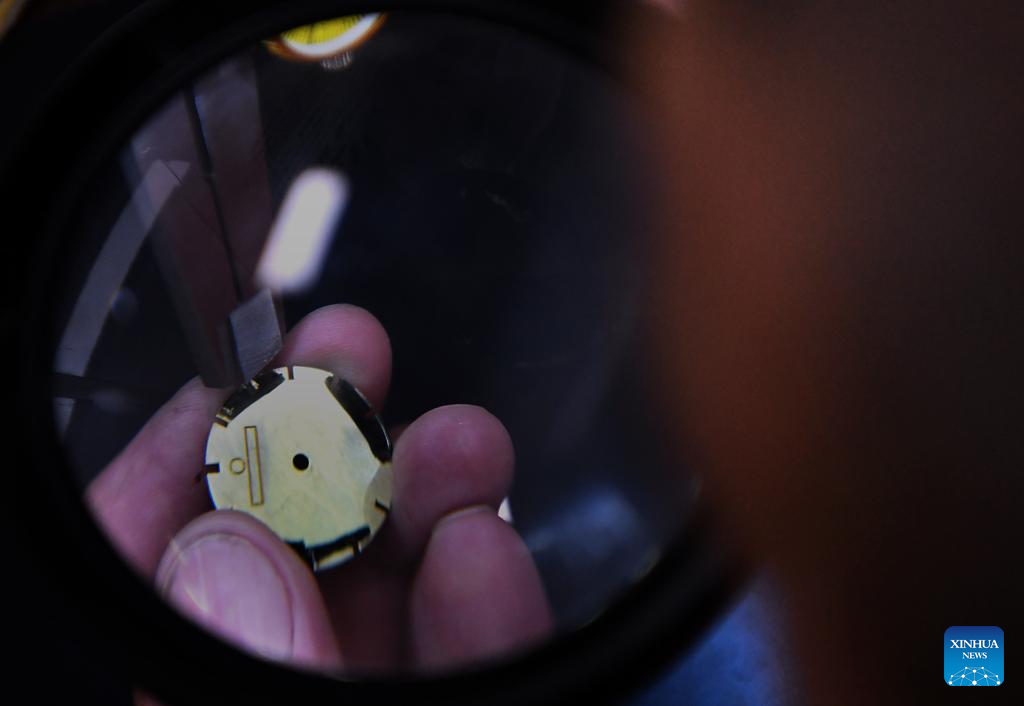
Cheng Yucai preprocesses a dial at his workshop in Xinmi City, central China's Henan Province, on May 23, 2022.
Guilloche is a decorative technique in which a precise, intricate and repetitive pattern is mechanically engraved into a material via engine turning. The technique uses a machine controlled by the delicacy of the hand of craftsman. As an important process in making superior watch and jewelry, the art is now mastered by rarely few people.
Cheng Yucai, born in 1978, got to know Guilloche in 2013 when he saw a cigarette case decorated with the technique. He was attracted by the delicacy and decided to devote himself into the art. In 2015, he resigned from his work in a silverwork factory and began his career in Guilloche. After countless failures and costs of materials, Cheng finally created an integrated Guilloche machine, which was granted with the country's patent of invention in 2017. His skills also amazed professional judges during the first national vocational skills competition in 2020.
Nowadays, Cheng's craft has been widely recognized by foreign customers, especially in France and Switzerland, who often book custom-made Guilloche designs from him. Cheng Yucai's workshop, which he names "Sanloutang" and is located in a kiln of Xinmi City of central China's Henan, is simple and crude but quiet enough for him to focus on the art. He moved to the vocational education center of Xinmi after the kiln was flooded by rainfall last summer, waiting for the fix of the workshop.
Guilloche requires delicacy of the craftsman, which includes a dozen processes such as flattening, underlining and carving. The precision is accurate to twentieth of the width of a hair. A simple Guilloche pattern costs seven to eight hours to make with 70,000 to 80,000 times turning of manual operation, while a complex one dozens of hours with more than 100,000 times turning. Any tiny mistake would make the whole work useless.
Nowadays, Cheng has enrolled three apprentices, to whom he teaches all the skills without reservation. Generally grasping the art, his apprentices are ready to take part in a world technique competition in October. "I wish the art would be passed through generations and be known and loved by more people, " Cheng said. (Xinhua/Li An)
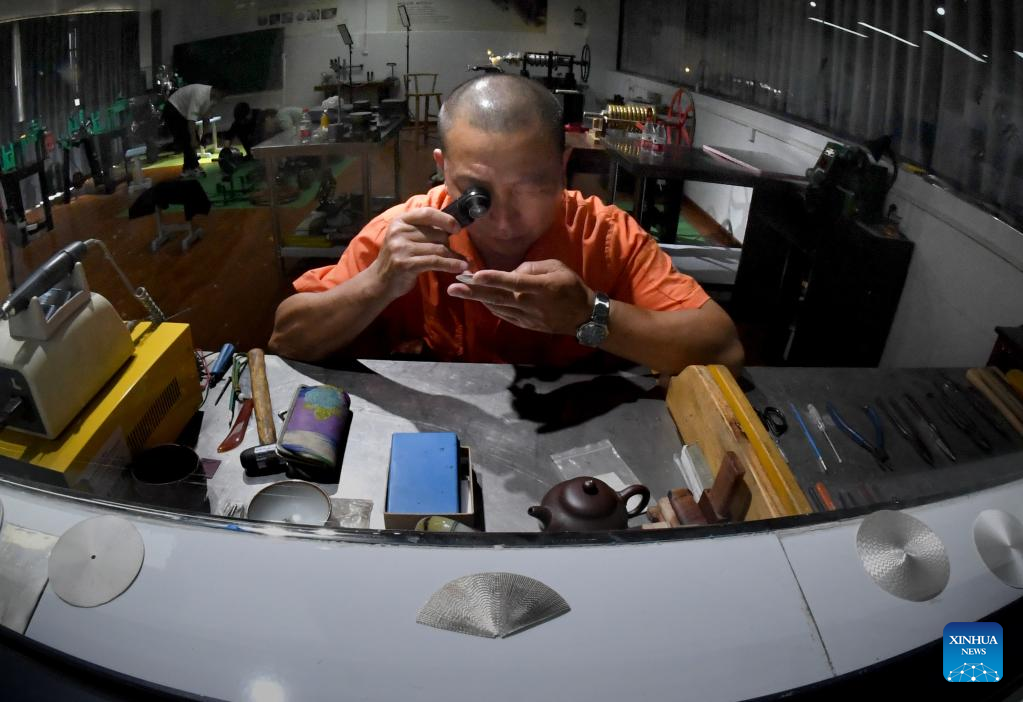
Cheng Yucai checks a processed dial at his workshop in Xinmi City, central China's Henan Province, on May 24, 2022.
Guilloche is a decorative technique in which a precise, intricate and repetitive pattern is mechanically engraved into a material via engine turning. The technique uses a machine controlled by the delicacy of the hand of craftsman. As an important process in making superior watch and jewelry, the art is now mastered by rarely few people.
Cheng Yucai, born in 1978, got to know Guilloche in 2013 when he saw a cigarette case decorated with the technique. He was attracted by the delicacy and decided to devote himself into the art. In 2015, he resigned from his work in a silverwork factory and began his career in Guilloche. After countless failures and costs of materials, Cheng finally created an integrated Guilloche machine, which was granted with the country's patent of invention in 2017. His skills also amazed professional judges during the first national vocational skills competition in 2020.
Nowadays, Cheng's craft has been widely recognized by foreign customers, especially in France and Switzerland, who often book custom-made Guilloche designs from him. Cheng Yucai's workshop, which he names "Sanloutang" and is located in a kiln of Xinmi City of central China's Henan, is simple and crude but quiet enough for him to focus on the art. He moved to the vocational education center of Xinmi after the kiln was flooded by rainfall last summer, waiting for the fix of the workshop.
Guilloche requires delicacy of the craftsman, which includes a dozen processes such as flattening, underlining and carving. The precision is accurate to twentieth of the width of a hair. A simple Guilloche pattern costs seven to eight hours to make with 70,000 to 80,000 times turning of manual operation, while a complex one dozens of hours with more than 100,000 times turning. Any tiny mistake would make the whole work useless.
Nowadays, Cheng has enrolled three apprentices, to whom he teaches all the skills without reservation. Generally grasping the art, his apprentices are ready to take part in a world technique competition in October. "I wish the art would be passed through generations and be known and loved by more people, " Cheng said. (Xinhua/Li An)
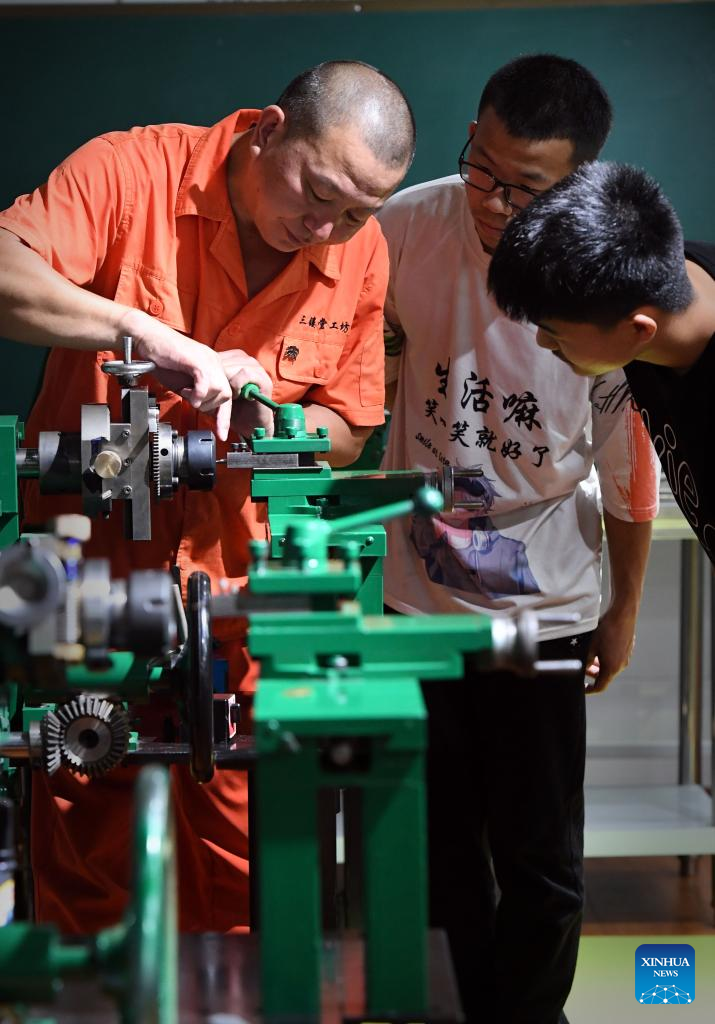
Cheng Yucai (L) explains the operation specifications of a Guilloche machine to his apprentices at his workshop in Xinmi City, central China's Henan Province, on May 24, 2022.
Guilloche is a decorative technique in which a precise, intricate and repetitive pattern is mechanically engraved into a material via engine turning. The technique uses a machine controlled by the delicacy of the hand of craftsman. As an important process in making superior watch and jewelry, the art is now mastered by rarely few people.
Cheng Yucai, born in 1978, got to know Guilloche in 2013 when he saw a cigarette case decorated with the technique. He was attracted by the delicacy and decided to devote himself into the art. In 2015, he resigned from his work in a silverwork factory and began his career in Guilloche. After countless failures and costs of materials, Cheng finally created an integrated Guilloche machine, which was granted with the country's patent of invention in 2017. His skills also amazed professional judges during the first national vocational skills competition in 2020.
Nowadays, Cheng's craft has been widely recognized by foreign customers, especially in France and Switzerland, who often book custom-made Guilloche designs from him. Cheng Yucai's workshop, which he names "Sanloutang" and is located in a kiln of Xinmi City of central China's Henan, is simple and crude but quiet enough for him to focus on the art. He moved to the vocational education center of Xinmi after the kiln was flooded by rainfall last summer, waiting for the fix of the workshop.
Guilloche requires delicacy of the craftsman, which includes a dozen processes such as flattening, underlining and carving. The precision is accurate to twentieth of the width of a hair. A simple Guilloche pattern costs seven to eight hours to make with 70,000 to 80,000 times turning of manual operation, while a complex one dozens of hours with more than 100,000 times turning. Any tiny mistake would make the whole work useless.
Nowadays, Cheng has enrolled three apprentices, to whom he teaches all the skills without reservation. Generally grasping the art, his apprentices are ready to take part in a world technique competition in October. "I wish the art would be passed through generations and be known and loved by more people, " Cheng said. (Xinhua/Li Jianan)

Cheng Yucai checks a processed dial at his workshop in Xinmi City, central China's Henan Province, on May 24, 2022.
Guilloche is a decorative technique in which a precise, intricate and repetitive pattern is mechanically engraved into a material via engine turning. The technique uses a machine controlled by the delicacy of the hand of craftsman. As an important process in making superior watch and jewelry, the art is now mastered by rarely few people.
Cheng Yucai, born in 1978, got to know Guilloche in 2013 when he saw a cigarette case decorated with the technique. He was attracted by the delicacy and decided to devote himself into the art. In 2015, he resigned from his work in a silverwork factory and began his career in Guilloche. After countless failures and costs of materials, Cheng finally created an integrated Guilloche machine, which was granted with the country's patent of invention in 2017. His skills also amazed professional judges during the first national vocational skills competition in 2020.
Nowadays, Cheng's craft has been widely recognized by foreign customers, especially in France and Switzerland, who often book custom-made Guilloche designs from him. Cheng Yucai's workshop, which he names "Sanloutang" and is located in a kiln of Xinmi City of central China's Henan, is simple and crude but quiet enough for him to focus on the art. He moved to the vocational education center of Xinmi after the kiln was flooded by rainfall last summer, waiting for the fix of the workshop.
Guilloche requires delicacy of the craftsman, which includes a dozen processes such as flattening, underlining and carving. The precision is accurate to twentieth of the width of a hair. A simple Guilloche pattern costs seven to eight hours to make with 70,000 to 80,000 times turning of manual operation, while a complex one dozens of hours with more than 100,000 times turning. Any tiny mistake would make the whole work useless.
Nowadays, Cheng has enrolled three apprentices, to whom he teaches all the skills without reservation. Generally grasping the art, his apprentices are ready to take part in a world technique competition in October. "I wish the art would be passed through generations and be known and loved by more people, " Cheng said. (Xinhua/Li Jianan)
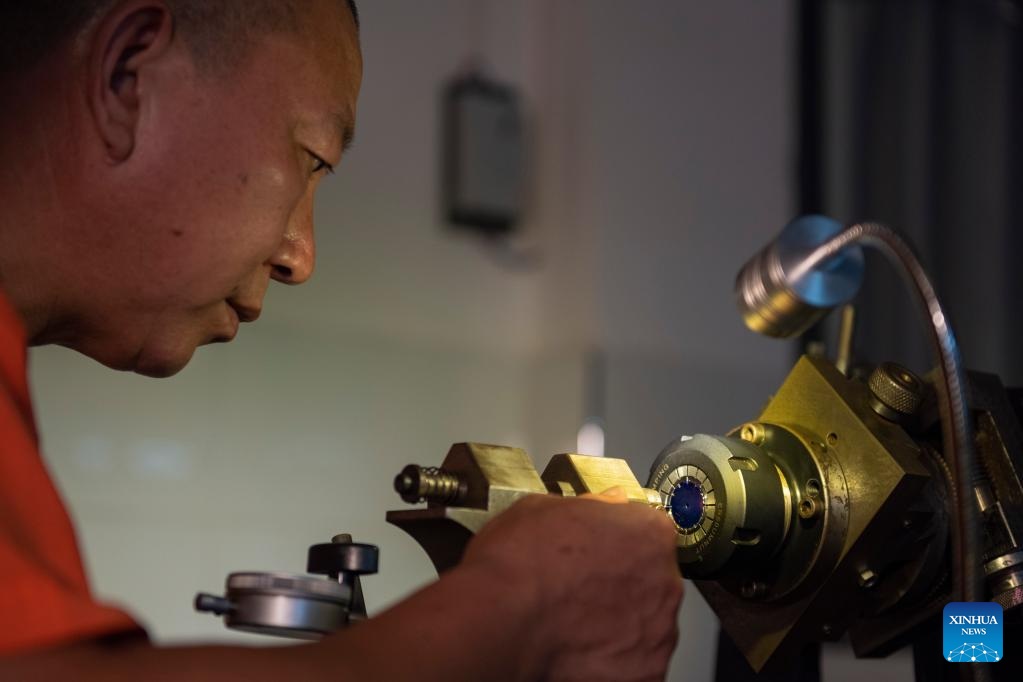
Cheng Yucai processes a dial at his workshop in Xinmi City, central China's Henan Province, on May 23, 2022.
Guilloche is a decorative technique in which a precise, intricate and repetitive pattern is mechanically engraved into a material via engine turning. The technique uses a machine controlled by the delicacy of the hand of craftsman. As an important process in making superior watch and jewelry, the art is now mastered by rarely few people.
Cheng Yucai, born in 1978, got to know Guilloche in 2013 when he saw a cigarette case decorated with the technique. He was attracted by the delicacy and decided to devote himself into the art. In 2015, he resigned from his work in a silverwork factory and began his career in Guilloche. After countless failures and costs of materials, Cheng finally created an integrated Guilloche machine, which was granted with the country's patent of invention in 2017. His skills also amazed professional judges during the first national vocational skills competition in 2020.
Nowadays, Cheng's craft has been widely recognized by foreign customers, especially in France and Switzerland, who often book custom-made Guilloche designs from him. Cheng Yucai's workshop, which he names "Sanloutang" and is located in a kiln of Xinmi City of central China's Henan, is simple and crude but quiet enough for him to focus on the art. He moved to the vocational education center of Xinmi after the kiln was flooded by rainfall last summer, waiting for the fix of the workshop.
Guilloche requires delicacy of the craftsman, which includes a dozen processes such as flattening, underlining and carving. The precision is accurate to twentieth of the width of a hair. A simple Guilloche pattern costs seven to eight hours to make with 70,000 to 80,000 times turning of manual operation, while a complex one dozens of hours with more than 100,000 times turning. Any tiny mistake would make the whole work useless.
Nowadays, Cheng has enrolled three apprentices, to whom he teaches all the skills without reservation. Generally grasping the art, his apprentices are ready to take part in a world technique competition in October. "I wish the art would be passed through generations and be known and loved by more people, " Cheng said. (Xinhua/Xu Jiayi)
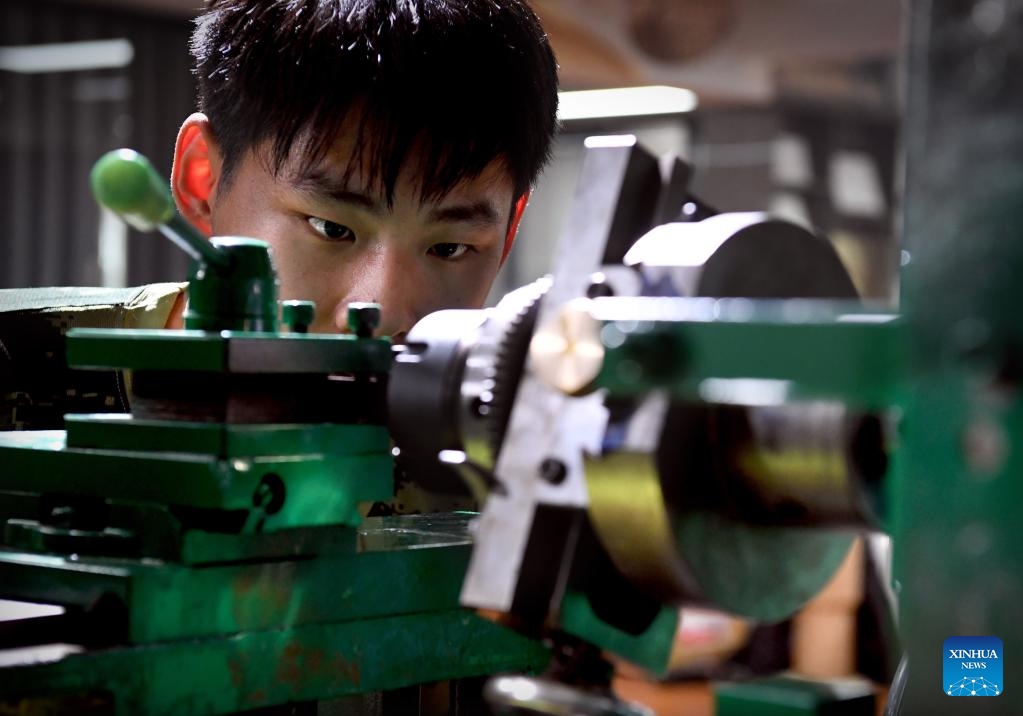
Cheng Yucai's apprentice Li Jinghang adjusts the Guilloche machine at Cheng's workshop in Xinmi City, central China's Henan Province, on May 24, 2022.
Guilloche is a decorative technique in which a precise, intricate and repetitive pattern is mechanically engraved into a material via engine turning. The technique uses a machine controlled by the delicacy of the hand of craftsman. As an important process in making superior watch and jewelry, the art is now mastered by rarely few people.
Cheng Yucai, born in 1978, got to know Guilloche in 2013 when he saw a cigarette case decorated with the technique. He was attracted by the delicacy and decided to devote himself into the art. In 2015, he resigned from his work in a silverwork factory and began his career in Guilloche. After countless failures and costs of materials, Cheng finally created an integrated Guilloche machine, which was granted with the country's patent of invention in 2017. His skills also amazed professional judges during the first national vocational skills competition in 2020.
Nowadays, Cheng's craft has been widely recognized by foreign customers, especially in France and Switzerland, who often book custom-made Guilloche designs from him. Cheng Yucai's workshop, which he names "Sanloutang" and is located in a kiln of Xinmi City of central China's Henan, is simple and crude but quiet enough for him to focus on the art. He moved to the vocational education center of Xinmi after the kiln was flooded by rainfall last summer, waiting for the fix of the workshop.
Guilloche requires delicacy of the craftsman, which includes a dozen processes such as flattening, underlining and carving. The precision is accurate to twentieth of the width of a hair. A simple Guilloche pattern costs seven to eight hours to make with 70,000 to 80,000 times turning of manual operation, while a complex one dozens of hours with more than 100,000 times turning. Any tiny mistake would make the whole work useless.
Nowadays, Cheng has enrolled three apprentices, to whom he teaches all the skills without reservation. Generally grasping the art, his apprentices are ready to take part in a world technique competition in October. "I wish the art would be passed through generations and be known and loved by more people, " Cheng said. (Xinhua/Li An)
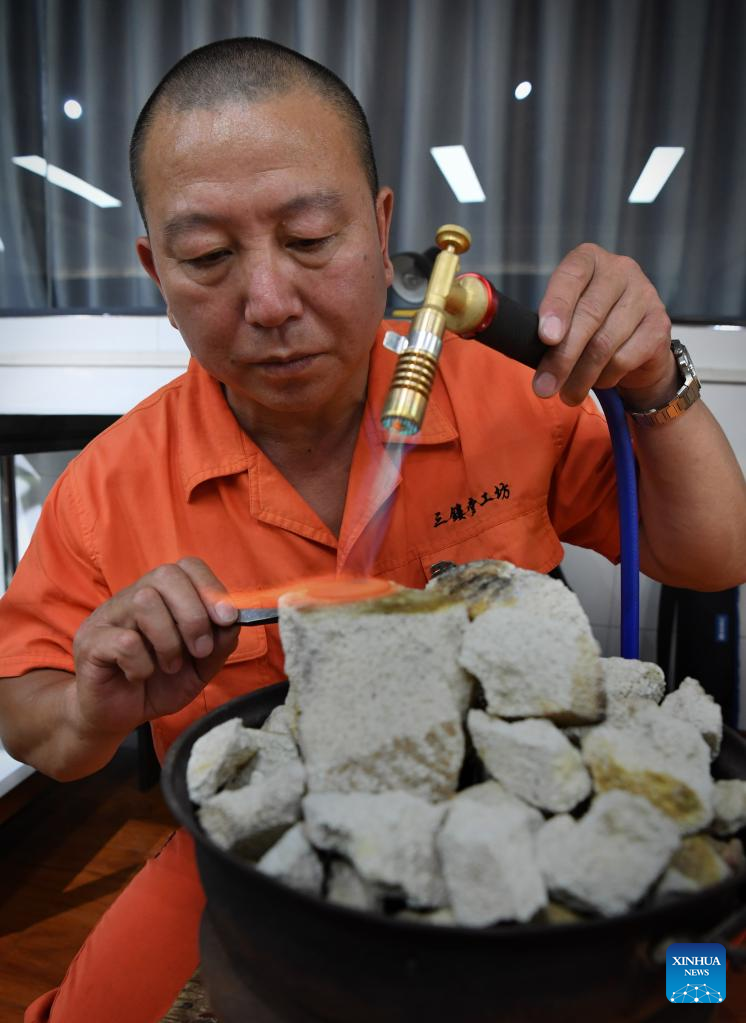
Cheng Yucai heats a processed dial at his workshop in Xinmi City, central China's Henan Province, on May 24, 2022.
Guilloche is a decorative technique in which a precise, intricate and repetitive pattern is mechanically engraved into a material via engine turning. The technique uses a machine controlled by the delicacy of the hand of craftsman. As an important process in making superior watch and jewelry, the art is now mastered by rarely few people.
Cheng Yucai, born in 1978, got to know Guilloche in 2013 when he saw a cigarette case decorated with the technique. He was attracted by the delicacy and decided to devote himself into the art. In 2015, he resigned from his work in a silverwork factory and began his career in Guilloche. After countless failures and costs of materials, Cheng finally created an integrated Guilloche machine, which was granted with the country's patent of invention in 2017. His skills also amazed professional judges during the first national vocational skills competition in 2020.
Nowadays, Cheng's craft has been widely recognized by foreign customers, especially in France and Switzerland, who often book custom-made Guilloche designs from him. Cheng Yucai's workshop, which he names "Sanloutang" and is located in a kiln of Xinmi City of central China's Henan, is simple and crude but quiet enough for him to focus on the art. He moved to the vocational education center of Xinmi after the kiln was flooded by rainfall last summer, waiting for the fix of the workshop.
Guilloche requires delicacy of the craftsman, which includes a dozen processes such as flattening, underlining and carving. The precision is accurate to twentieth of the width of a hair. A simple Guilloche pattern costs seven to eight hours to make with 70,000 to 80,000 times turning of manual operation, while a complex one dozens of hours with more than 100,000 times turning. Any tiny mistake would make the whole work useless.
Nowadays, Cheng has enrolled three apprentices, to whom he teaches all the skills without reservation. Generally grasping the art, his apprentices are ready to take part in a world technique competition in October. "I wish the art would be passed through generations and be known and loved by more people, " Cheng said. (Xinhua/Li Jianan)
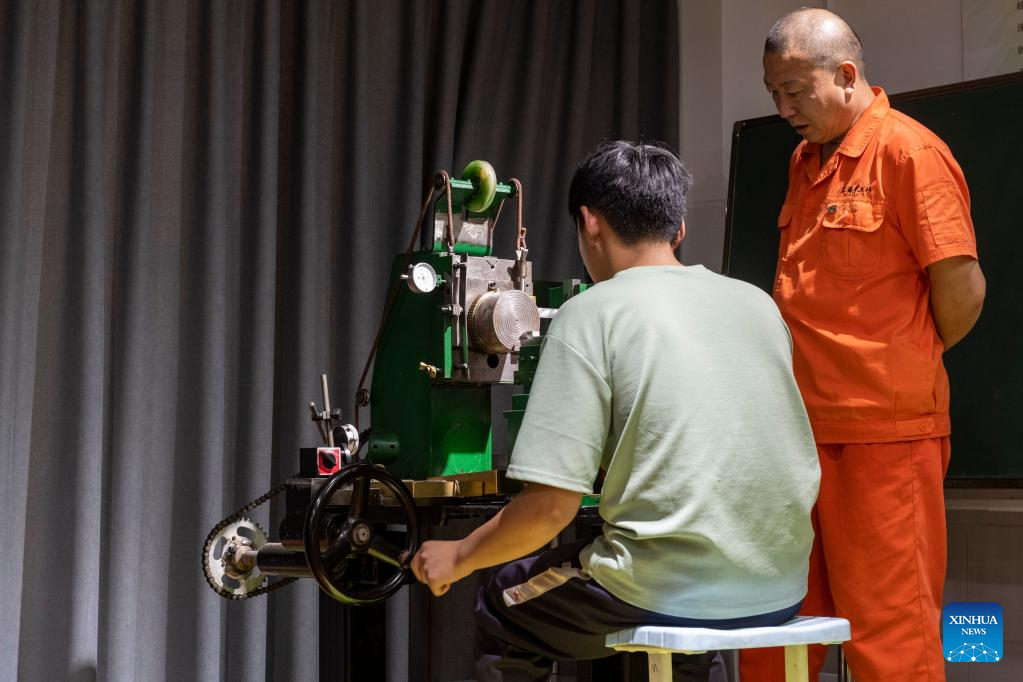
Cheng Yucai (R) guides an apprentice to operate a Guilloche machine at his workshop in Xinmi City, central China's Henan Province, on May 24, 2022.
Guilloche is a decorative technique in which a precise, intricate and repetitive pattern is mechanically engraved into a material via engine turning. The technique uses a machine controlled by the delicacy of the hand of craftsman. As an important process in making superior watch and jewelry, the art is now mastered by rarely few people.
Cheng Yucai, born in 1978, got to know Guilloche in 2013 when he saw a cigarette case decorated with the technique. He was attracted by the delicacy and decided to devote himself into the art. In 2015, he resigned from his work in a silverwork factory and began his career in Guilloche. After countless failures and costs of materials, Cheng finally created an integrated Guilloche machine, which was granted with the country's patent of invention in 2017. His skills also amazed professional judges during the first national vocational skills competition in 2020.
Nowadays, Cheng's craft has been widely recognized by foreign customers, especially in France and Switzerland, who often book custom-made Guilloche designs from him. Cheng Yucai's workshop, which he names "Sanloutang" and is located in a kiln of Xinmi City of central China's Henan, is simple and crude but quiet enough for him to focus on the art. He moved to the vocational education center of Xinmi after the kiln was flooded by rainfall last summer, waiting for the fix of the workshop.
Guilloche requires delicacy of the craftsman, which includes a dozen processes such as flattening, underlining and carving. The precision is accurate to twentieth of the width of a hair. A simple Guilloche pattern costs seven to eight hours to make with 70,000 to 80,000 times turning of manual operation, while a complex one dozens of hours with more than 100,000 times turning. Any tiny mistake would make the whole work useless.
Nowadays, Cheng has enrolled three apprentices, to whom he teaches all the skills without reservation. Generally grasping the art, his apprentices are ready to take part in a world technique competition in October. "I wish the art would be passed through generations and be known and loved by more people, " Cheng said. (Xinhua/Xu Jiayi)

Cheng Yucai's apprentices dismantle a Guilloche machine at Cheng's workshop in Xinmi City, central China's Henan Province, on May 24, 2022.
Guilloche is a decorative technique in which a precise, intricate and repetitive pattern is mechanically engraved into a material via engine turning. The technique uses a machine controlled by the delicacy of the hand of craftsman. As an important process in making superior watch and jewelry, the art is now mastered by rarely few people.
Cheng Yucai, born in 1978, got to know Guilloche in 2013 when he saw a cigarette case decorated with the technique. He was attracted by the delicacy and decided to devote himself into the art. In 2015, he resigned from his work in a silverwork factory and began his career in Guilloche. After countless failures and costs of materials, Cheng finally created an integrated Guilloche machine, which was granted with the country's patent of invention in 2017. His skills also amazed professional judges during the first national vocational skills competition in 2020.
Nowadays, Cheng's craft has been widely recognized by foreign customers, especially in France and Switzerland, who often book custom-made Guilloche designs from him. Cheng Yucai's workshop, which he names "Sanloutang" and is located in a kiln of Xinmi City of central China's Henan, is simple and crude but quiet enough for him to focus on the art. He moved to the vocational education center of Xinmi after the kiln was flooded by rainfall last summer, waiting for the fix of the workshop.
Guilloche requires delicacy of the craftsman, which includes a dozen processes such as flattening, underlining and carving. The precision is accurate to twentieth of the width of a hair. A simple Guilloche pattern costs seven to eight hours to make with 70,000 to 80,000 times turning of manual operation, while a complex one dozens of hours with more than 100,000 times turning. Any tiny mistake would make the whole work useless.
Nowadays, Cheng has enrolled three apprentices, to whom he teaches all the skills without reservation. Generally grasping the art, his apprentices are ready to take part in a world technique competition in October. "I wish the art would be passed through generations and be known and loved by more people, " Cheng said. (Xinhua/Xu Jiayi)

Cheng Yucai's apprentices practice to operate Guilloche machines at his workshop in Xinmi City, central China's Henan Province, on May 24, 2022.
Guilloche is a decorative technique in which a precise, intricate and repetitive pattern is mechanically engraved into a material via engine turning. The technique uses a machine controlled by the delicacy of the hand of craftsman. As an important process in making superior watch and jewelry, the art is now mastered by rarely few people.
Cheng Yucai, born in 1978, got to know Guilloche in 2013 when he saw a cigarette case decorated with the technique. He was attracted by the delicacy and decided to devote himself into the art. In 2015, he resigned from his work in a silverwork factory and began his career in Guilloche. After countless failures and costs of materials, Cheng finally created an integrated Guilloche machine, which was granted with the country's patent of invention in 2017. His skills also amazed professional judges during the first national vocational skills competition in 2020.
Nowadays, Cheng's craft has been widely recognized by foreign customers, especially in France and Switzerland, who often book custom-made Guilloche designs from him. Cheng Yucai's workshop, which he names "Sanloutang" and is located in a kiln of Xinmi City of central China's Henan, is simple and crude but quiet enough for him to focus on the art. He moved to the vocational education center of Xinmi after the kiln was flooded by rainfall last summer, waiting for the fix of the workshop.
Guilloche requires delicacy of the craftsman, which includes a dozen processes such as flattening, underlining and carving. The precision is accurate to twentieth of the width of a hair. A simple Guilloche pattern costs seven to eight hours to make with 70,000 to 80,000 times turning of manual operation, while a complex one dozens of hours with more than 100,000 times turning. Any tiny mistake would make the whole work useless.
Nowadays, Cheng has enrolled three apprentices, to whom he teaches all the skills without reservation. Generally grasping the art, his apprentices are ready to take part in a world technique competition in October. "I wish the art would be passed through generations and be known and loved by more people, " Cheng said. (Xinhua/Li An)
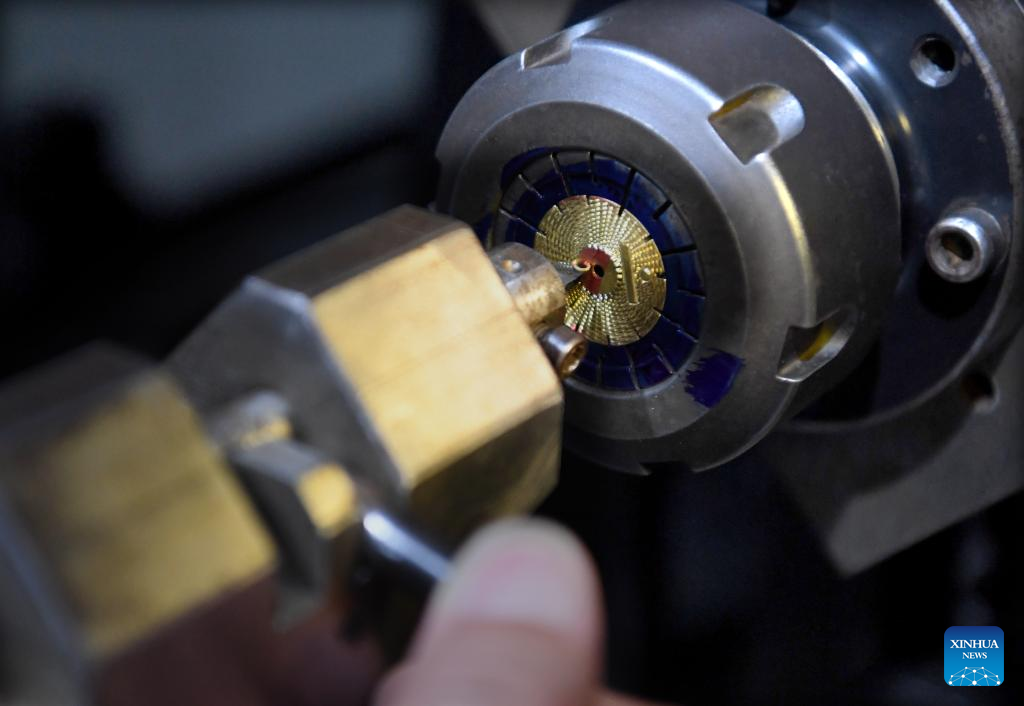
Cheng Yucai works on a dial by a Guilloche machine at his workshop in Xinmi City, central China's Henan Province, on May 23, 2022.
Guilloche is a decorative technique in which a precise, intricate and repetitive pattern is mechanically engraved into a material via engine turning. The technique uses a machine controlled by the delicacy of the hand of craftsman. As an important process in making superior watch and jewelry, the art is now mastered by rarely few people.
Cheng Yucai, born in 1978, got to know Guilloche in 2013 when he saw a cigarette case decorated with the technique. He was attracted by the delicacy and decided to devote himself into the art. In 2015, he resigned from his work in a silverwork factory and began his career in Guilloche. After countless failures and costs of materials, Cheng finally created an integrated Guilloche machine, which was granted with the country's patent of invention in 2017. His skills also amazed professional judges during the first national vocational skills competition in 2020.
Nowadays, Cheng's craft has been widely recognized by foreign customers, especially in France and Switzerland, who often book custom-made Guilloche designs from him. Cheng Yucai's workshop, which he names "Sanloutang" and is located in a kiln of Xinmi City of central China's Henan, is simple and crude but quiet enough for him to focus on the art. He moved to the vocational education center of Xinmi after the kiln was flooded by rainfall last summer, waiting for the fix of the workshop.
Guilloche requires delicacy of the craftsman, which includes a dozen processes such as flattening, underlining and carving. The precision is accurate to twentieth of the width of a hair. A simple Guilloche pattern costs seven to eight hours to make with 70,000 to 80,000 times turning of manual operation, while a complex one dozens of hours with more than 100,000 times turning. Any tiny mistake would make the whole work useless.
Nowadays, Cheng has enrolled three apprentices, to whom he teaches all the skills without reservation. Generally grasping the art, his apprentices are ready to take part in a world technique competition in October. "I wish the art would be passed through generations and be known and loved by more people, " Cheng said. (Xinhua/Li Jianan)
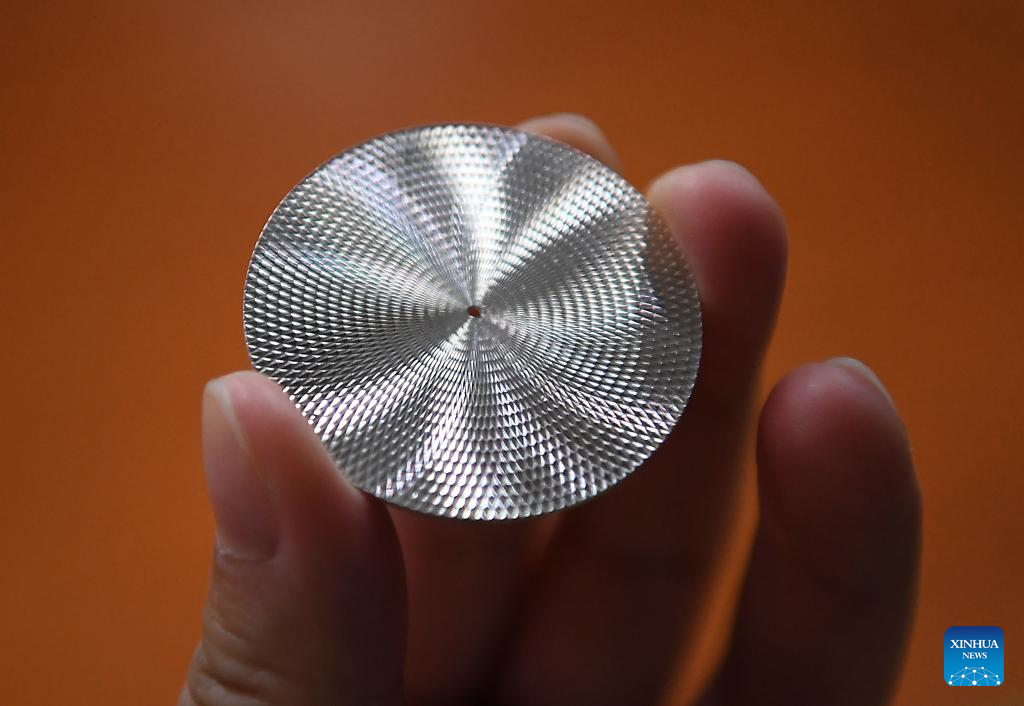
Photo taken on May 23, 2022 shows a processed dial at Cheng Yucai's workshop in Xinmi City, central China's Henan Province.
Guilloche is a decorative technique in which a precise, intricate and repetitive pattern is mechanically engraved into a material via engine turning. The technique uses a machine controlled by the delicacy of the hand of craftsman. As an important process in making superior watch and jewelry, the art is now mastered by rarely few people.
Cheng Yucai, born in 1978, got to know Guilloche in 2013 when he saw a cigarette case decorated with the technique. He was attracted by the delicacy and decided to devote himself into the art. In 2015, he resigned from his work in a silverwork factory and began his career in Guilloche. After countless failures and costs of materials, Cheng finally created an integrated Guilloche machine, which was granted with the country's patent of invention in 2017. His skills also amazed professional judges during the first national vocational skills competition in 2020.
Nowadays, Cheng's craft has been widely recognized by foreign customers, especially in France and Switzerland, who often book custom-made Guilloche designs from him. Cheng Yucai's workshop, which he names "Sanloutang" and is located in a kiln of Xinmi City of central China's Henan, is simple and crude but quiet enough for him to focus on the art. He moved to the vocational education center of Xinmi after the kiln was flooded by rainfall last summer, waiting for the fix of the workshop.
Guilloche requires delicacy of the craftsman, which includes a dozen processes such as flattening, underlining and carving. The precision is accurate to twentieth of the width of a hair. A simple Guilloche pattern costs seven to eight hours to make with 70,000 to 80,000 times turning of manual operation, while a complex one dozens of hours with more than 100,000 times turning. Any tiny mistake would make the whole work useless.
Nowadays, Cheng has enrolled three apprentices, to whom he teaches all the skills without reservation. Generally grasping the art, his apprentices are ready to take part in a world technique competition in October. "I wish the art would be passed through generations and be known and loved by more people, " Cheng said. (Xinhua/Li Jianan)
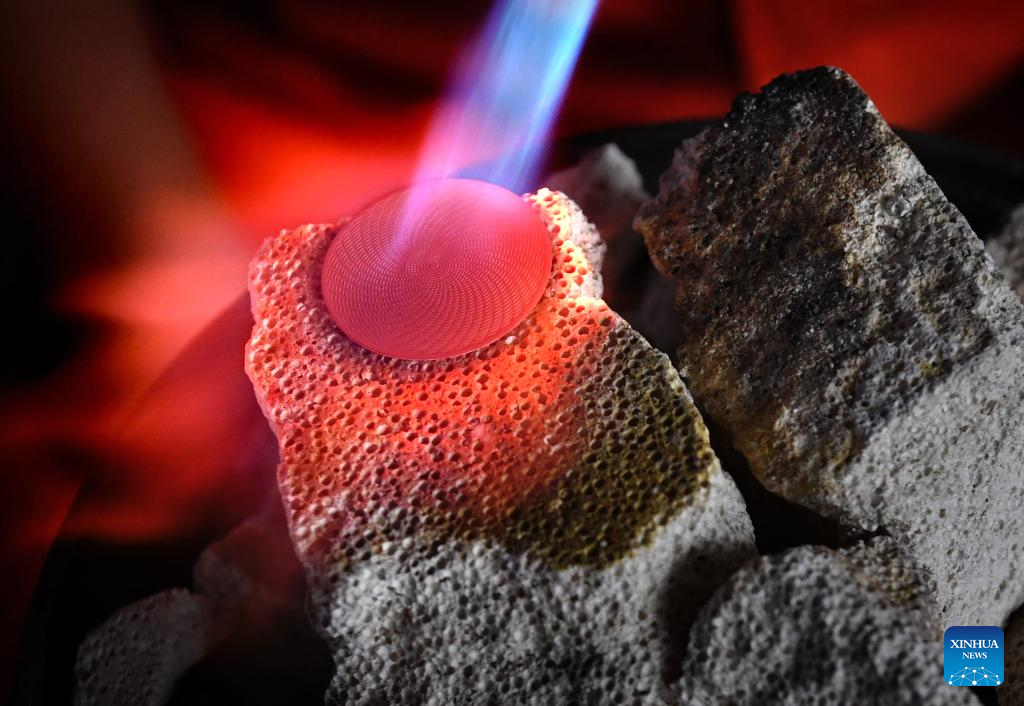
Cheng Yucai heats a processed dial at his workshop in Xinmi City, central China's Henan Province, on May 24, 2022.
Guilloche is a decorative technique in which a precise, intricate and repetitive pattern is mechanically engraved into a material via engine turning. The technique uses a machine controlled by the delicacy of the hand of craftsman. As an important process in making superior watch and jewelry, the art is now mastered by rarely few people.
Cheng Yucai, born in 1978, got to know Guilloche in 2013 when he saw a cigarette case decorated with the technique. He was attracted by the delicacy and decided to devote himself into the art. In 2015, he resigned from his work in a silverwork factory and began his career in Guilloche. After countless failures and costs of materials, Cheng finally created an integrated Guilloche machine, which was granted with the country's patent of invention in 2017. His skills also amazed professional judges during the first national vocational skills competition in 2020.
Nowadays, Cheng's craft has been widely recognized by foreign customers, especially in France and Switzerland, who often book custom-made Guilloche designs from him. Cheng Yucai's workshop, which he names "Sanloutang" and is located in a kiln of Xinmi City of central China's Henan, is simple and crude but quiet enough for him to focus on the art. He moved to the vocational education center of Xinmi after the kiln was flooded by rainfall last summer, waiting for the fix of the workshop.
Guilloche requires delicacy of the craftsman, which includes a dozen processes such as flattening, underlining and carving. The precision is accurate to twentieth of the width of a hair. A simple Guilloche pattern costs seven to eight hours to make with 70,000 to 80,000 times turning of manual operation, while a complex one dozens of hours with more than 100,000 times turning. Any tiny mistake would make the whole work useless.
Nowadays, Cheng has enrolled three apprentices, to whom he teaches all the skills without reservation. Generally grasping the art, his apprentices are ready to take part in a world technique competition in October. "I wish the art would be passed through generations and be known and loved by more people, " Cheng said. (Xinhua/Li An)
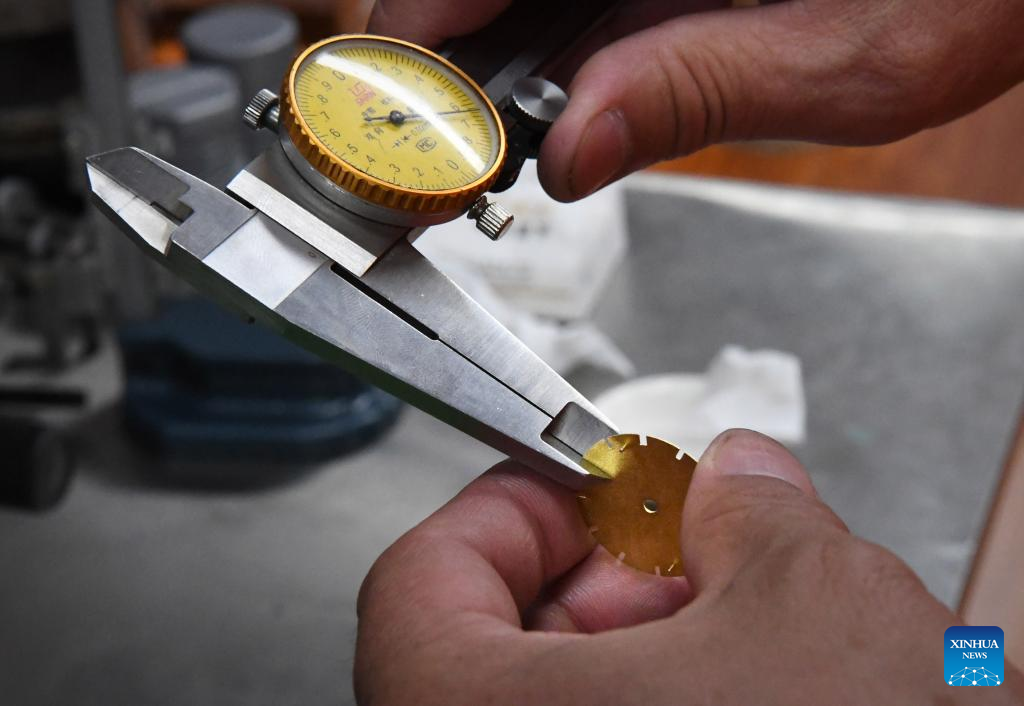
Cheng Yucai measures the thickness of a dial at his workshop in Xinmi City, central China's Henan Province, on May 23, 2022.
Guilloche is a decorative technique in which a precise, intricate and repetitive pattern is mechanically engraved into a material via engine turning. The technique uses a machine controlled by the delicacy of the hand of craftsman. As an important process in making superior watch and jewelry, the art is now mastered by rarely few people.
Cheng Yucai, born in 1978, got to know Guilloche in 2013 when he saw a cigarette case decorated with the technique. He was attracted by the delicacy and decided to devote himself into the art. In 2015, he resigned from his work in a silverwork factory and began his career in Guilloche. After countless failures and costs of materials, Cheng finally created an integrated Guilloche machine, which was granted with the country's patent of invention in 2017. His skills also amazed professional judges during the first national vocational skills competition in 2020.
Nowadays, Cheng's craft has been widely recognized by foreign customers, especially in France and Switzerland, who often book custom-made Guilloche designs from him. Cheng Yucai's workshop, which he names "Sanloutang" and is located in a kiln of Xinmi City of central China's Henan, is simple and crude but quiet enough for him to focus on the art. He moved to the vocational education center of Xinmi after the kiln was flooded by rainfall last summer, waiting for the fix of the workshop.
Guilloche requires delicacy of the craftsman, which includes a dozen processes such as flattening, underlining and carving. The precision is accurate to twentieth of the width of a hair. A simple Guilloche pattern costs seven to eight hours to make with 70,000 to 80,000 times turning of manual operation, while a complex one dozens of hours with more than 100,000 times turning. Any tiny mistake would make the whole work useless.
Nowadays, Cheng has enrolled three apprentices, to whom he teaches all the skills without reservation. Generally grasping the art, his apprentices are ready to take part in a world technique competition in October. "I wish the art would be passed through generations and be known and loved by more people, " Cheng said. (Xinhua/Li An)
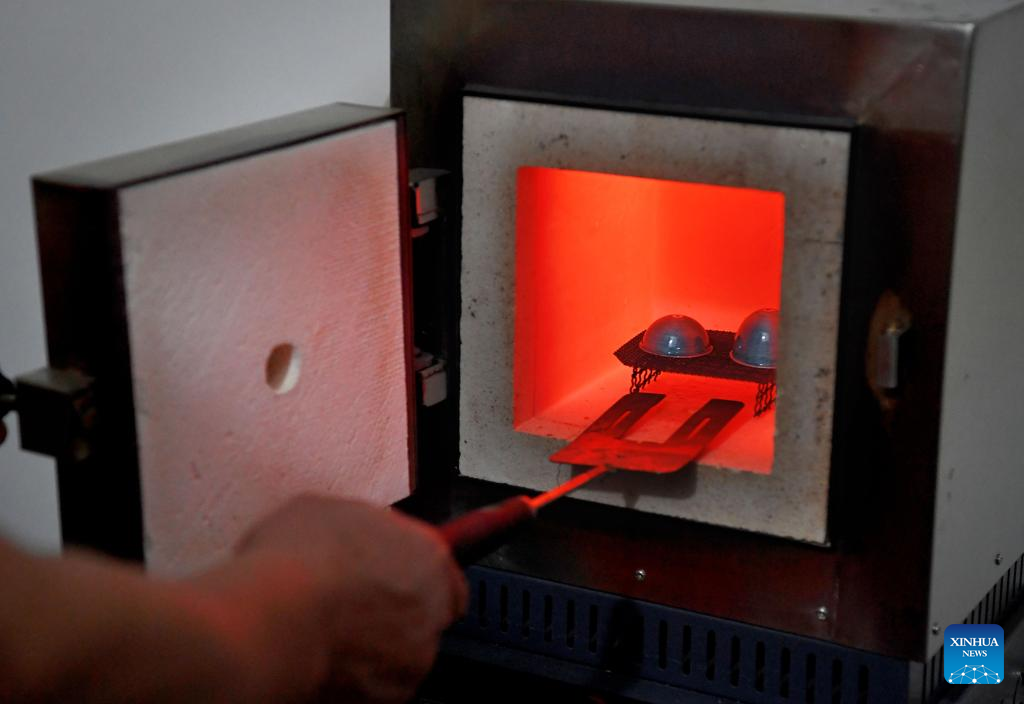
Cheng Yucai fires enamel for works of Guilloche at his workshop in Xinmi City, central China's Henan Province, on May 24, 2022.
Guilloche is a decorative technique in which a precise, intricate and repetitive pattern is mechanically engraved into a material via engine turning. The technique uses a machine controlled by the delicacy of the hand of craftsman. As an important process in making superior watch and jewelry, the art is now mastered by rarely few people.
Cheng Yucai, born in 1978, got to know Guilloche in 2013 when he saw a cigarette case decorated with the technique. He was attracted by the delicacy and decided to devote himself into the art. In 2015, he resigned from his work in a silverwork factory and began his career in Guilloche. After countless failures and costs of materials, Cheng finally created an integrated Guilloche machine, which was granted with the country's patent of invention in 2017. His skills also amazed professional judges during the first national vocational skills competition in 2020.
Nowadays, Cheng's craft has been widely recognized by foreign customers, especially in France and Switzerland, who often book custom-made Guilloche designs from him. Cheng Yucai's workshop, which he names "Sanloutang" and is located in a kiln of Xinmi City of central China's Henan, is simple and crude but quiet enough for him to focus on the art. He moved to the vocational education center of Xinmi after the kiln was flooded by rainfall last summer, waiting for the fix of the workshop.
Guilloche requires delicacy of the craftsman, which includes a dozen processes such as flattening, underlining and carving. The precision is accurate to twentieth of the width of a hair. A simple Guilloche pattern costs seven to eight hours to make with 70,000 to 80,000 times turning of manual operation, while a complex one dozens of hours with more than 100,000 times turning. Any tiny mistake would make the whole work useless.
Nowadays, Cheng has enrolled three apprentices, to whom he teaches all the skills without reservation. Generally grasping the art, his apprentices are ready to take part in a world technique competition in October. "I wish the art would be passed through generations and be known and loved by more people, " Cheng said. (Xinhua/Li Jianan)

Cheng Yucai draws lines on a dial at his workshop in Xinmi City, central China's Henan Province, on May 23, 2022.
Guilloche is a decorative technique in which a precise, intricate and repetitive pattern is mechanically engraved into a material via engine turning. The technique uses a machine controlled by the delicacy of the hand of craftsman. As an important process in making superior watch and jewelry, the art is now mastered by rarely few people.
Cheng Yucai, born in 1978, got to know Guilloche in 2013 when he saw a cigarette case decorated with the technique. He was attracted by the delicacy and decided to devote himself into the art. In 2015, he resigned from his work in a silverwork factory and began his career in Guilloche. After countless failures and costs of materials, Cheng finally created an integrated Guilloche machine, which was granted with the country's patent of invention in 2017. His skills also amazed professional judges during the first national vocational skills competition in 2020.
Nowadays, Cheng's craft has been widely recognized by foreign customers, especially in France and Switzerland, who often book custom-made Guilloche designs from him. Cheng Yucai's workshop, which he names "Sanloutang" and is located in a kiln of Xinmi City of central China's Henan, is simple and crude but quiet enough for him to focus on the art. He moved to the vocational education center of Xinmi after the kiln was flooded by rainfall last summer, waiting for the fix of the workshop.
Guilloche requires delicacy of the craftsman, which includes a dozen processes such as flattening, underlining and carving. The precision is accurate to twentieth of the width of a hair. A simple Guilloche pattern costs seven to eight hours to make with 70,000 to 80,000 times turning of manual operation, while a complex one dozens of hours with more than 100,000 times turning. Any tiny mistake would make the whole work useless.
Nowadays, Cheng has enrolled three apprentices, to whom he teaches all the skills without reservation. Generally grasping the art, his apprentices are ready to take part in a world technique competition in October. "I wish the art would be passed through generations and be known and loved by more people, " Cheng said. (Xinhua/Xu Jiayi)

Combo photo taken on May 24, 2022 shows Cheng Yucai's works of Guilloche at his workshop in Xinmi City, central China's Henan Province.
Guilloche is a decorative technique in which a precise, intricate and repetitive pattern is mechanically engraved into a material via engine turning. The technique uses a machine controlled by the delicacy of the hand of craftsman. As an important process in making superior watch and jewelry, the art is now mastered by rarely few people.
Cheng Yucai, born in 1978, got to know Guilloche in 2013 when he saw a cigarette case decorated with the technique. He was attracted by the delicacy and decided to devote himself into the art. In 2015, he resigned from his work in a silverwork factory and began his career in Guilloche. After countless failures and costs of materials, Cheng finally created an integrated Guilloche machine, which was granted with the country's patent of invention in 2017. His skills also amazed professional judges during the first national vocational skills competition in 2020.
Nowadays, Cheng's craft has been widely recognized by foreign customers, especially in France and Switzerland, who often book custom-made Guilloche designs from him. Cheng Yucai's workshop, which he names "Sanloutang" and is located in a kiln of Xinmi City of central China's Henan, is simple and crude but quiet enough for him to focus on the art. He moved to the vocational education center of Xinmi after the kiln was flooded by rainfall last summer, waiting for the fix of the workshop.
Guilloche requires delicacy of the craftsman, which includes a dozen processes such as flattening, underlining and carving. The precision is accurate to twentieth of the width of a hair. A simple Guilloche pattern costs seven to eight hours to make with 70,000 to 80,000 times turning of manual operation, while a complex one dozens of hours with more than 100,000 times turning. Any tiny mistake would make the whole work useless.
Nowadays, Cheng has enrolled three apprentices, to whom he teaches all the skills without reservation. Generally grasping the art, his apprentices are ready to take part in a world technique competition in October. "I wish the art would be passed through generations and be known and loved by more people, " Cheng said. (Xinhua/Li An)
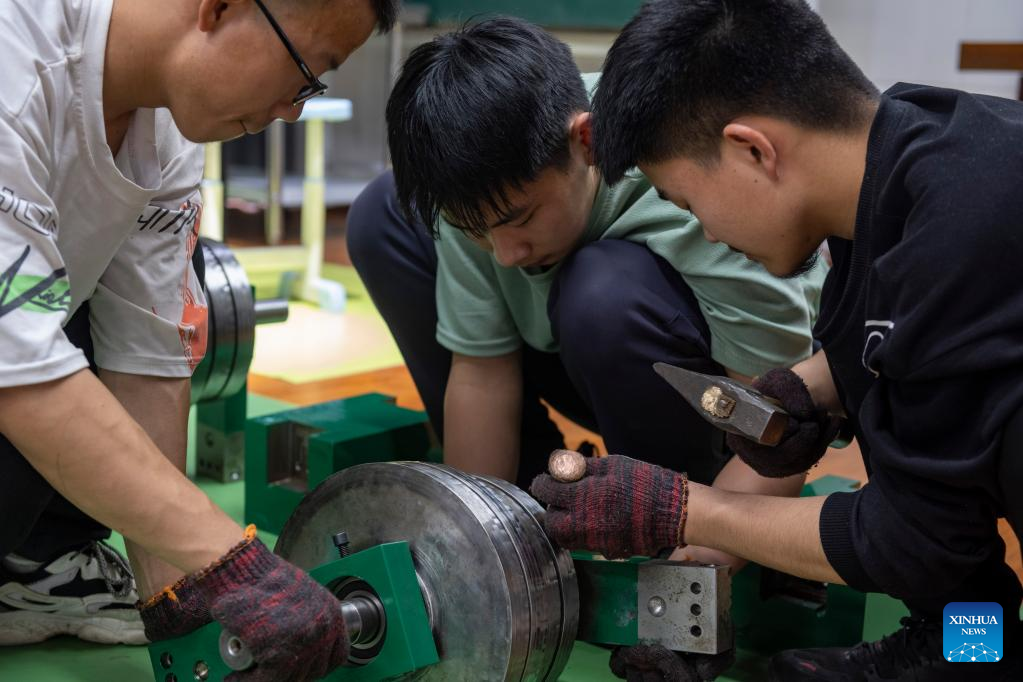
Cheng Yucai's apprentices dismantle a Guilloche machine at Cheng's workshop in Xinmi City, central China's Henan Province, on May 24, 2022.
Guilloche is a decorative technique in which a precise, intricate and repetitive pattern is mechanically engraved into a material via engine turning. The technique uses a machine controlled by the delicacy of the hand of craftsman. As an important process in making superior watch and jewelry, the art is now mastered by rarely few people.
Cheng Yucai, born in 1978, got to know Guilloche in 2013 when he saw a cigarette case decorated with the technique. He was attracted by the delicacy and decided to devote himself into the art. In 2015, he resigned from his work in a silverwork factory and began his career in Guilloche. After countless failures and costs of materials, Cheng finally created an integrated Guilloche machine, which was granted with the country's patent of invention in 2017. His skills also amazed professional judges during the first national vocational skills competition in 2020.
Nowadays, Cheng's craft has been widely recognized by foreign customers, especially in France and Switzerland, who often book custom-made Guilloche designs from him. Cheng Yucai's workshop, which he names "Sanloutang" and is located in a kiln of Xinmi City of central China's Henan, is simple and crude but quiet enough for him to focus on the art. He moved to the vocational education center of Xinmi after the kiln was flooded by rainfall last summer, waiting for the fix of the workshop.
Guilloche requires delicacy of the craftsman, which includes a dozen processes such as flattening, underlining and carving. The precision is accurate to twentieth of the width of a hair. A simple Guilloche pattern costs seven to eight hours to make with 70,000 to 80,000 times turning of manual operation, while a complex one dozens of hours with more than 100,000 times turning. Any tiny mistake would make the whole work useless.
Nowadays, Cheng has enrolled three apprentices, to whom he teaches all the skills without reservation. Generally grasping the art, his apprentices are ready to take part in a world technique competition in October. "I wish the art would be passed through generations and be known and loved by more people, " Cheng said. (Xinhua/Xu Jiayi)



